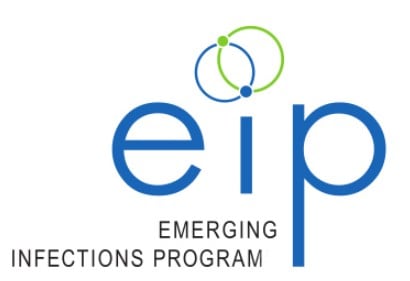At a glance
Emerging Infections Program (EIP) network sites collect, monitor, and disseminate data related to foodborne illnesses, healthcare associated infections, respiratory viruses, and other emerging infectious diseases.

Overview
Emerging Infections Program (EIP) activities focus on surveillance, applied research, and flexible and enhanced responses to emerging issues. These efforts generate reliable incidence estimates and provide critical information on risk factors, spectrum of disease, and intervention impact.
ABCs
Active Bacterial Core surveillance (ABCs) is a laboratory- and population-based surveillance system for five bacterial pathogens:
- group A Streptococcus
- group B Streptococcus
- Haemophilus influenzae
- Neisseria meningitidis
- Streptococcus pneumoniae
ABCs provides estimates of invasive disease burden and trends for these pathogens. ABCs also monitors changes in antimicrobial resistance and other characteristics through collection of bacterial isolates and demographic and clinical data.
View data from ABCs using Bact Facts Interactive.
COVID-NET
The COVID-19 Associated Hospitalization Surveillance Network (COVID-NET) is a population-based surveillance platform for laboratory-confirmed COVID-19-associated hospitalizations among children and adults. COVID-NET provides estimates of overall and age-specific COVID-19-associated hospitalization rates. The platform also describes the characteristics, clinical features, and clinical course of people hospitalized with COVID-19 infection. COVID-NET is one of three Respiratory Virus Hospitalization Surveillance Network (RESP-NET) surveillance platforms. Data are displayed on the COVID-NET interactive dashboard and the RESP-NET interactive dashboard.
FoodNet
The Foodborne Diseases Active Surveillance Network (FoodNet) tracks trends for infections commonly transmitted through food. FoodNet estimates the number of foodborne illnesses in the US, monitors trends in incidence of specific foodborne illnesses over time, attributes illnesses to specific foods and settings, and disseminates this information to improve public health practice and guide interventions to reduce the burden of foodborne illness.
HAIC
Healthcare Associated Infections - Community Interface (HAIC) surveillance activities and special projects seek to promote patient safety and healthcare quality through:
- evaluation of the epidemiology and public health impact of healthcare-associated infections (HAIs), antimicrobial resistance (AR), and other healthcare-related adverse events,
- assessment of the effect of HAI and AR prevention and control strategies,
- development and exploration of innovations in healthcare safety surveillance methods, and
- identification of health disparities among persons affected by HAIs or AR and opportunities for interventions.
Read more about HAIC activities and explore HAIC data.
HPV-IMPACT
The Human Papillomavirus (HPV) Vaccine Impact Monitoring Project (HPV-IMPACT) provides surveillance for cervical lesions that could progress to invasive cervical cancer. HPV-IMPACT data allow scientists to monitor the impact of the HPV vaccination program in the United States and evaluate vaccine effectiveness.
Read publications about HPV-IMPACT produced by members of the EIP Network.
FluSurv-NET
The Influenza Hospitalization Surveillance Network (FluSurv-NET) conducts surveillance for laboratory-confirmed influenza-associated hospitalizations in children and adults. FluSurv-NET provides estimates of overall and age-specific influenza-associated hospitalization rates. FluSurv-NET also describes the characteristics, clinical features, and clinical course of people hospitalized with influenza infection. The platform contributes to the estimation of annual and weekly disease burden of influenza in the US. FluSurv-NET data are updated weekly on FluView Interactive.
Read publications about FluSurv-NET produced by members of the EIP Network.
Mpox Vaccine Effectiveness Evaluation
This multi-jurisdictional case-control study evaluated the effectiveness and durability of JYNNEOS ™ vaccine against mpox disease. These data were critical to informing public health decision-making and vaccine policy for the control and prevention of mpox.
Read the most current mpox MMWR produced by members of the EIP Network.
Prion
Prion surveillance monitors the continued absence of new forms of human prion disease and tracks trends in Creutzfeldt-Jakob disease. These activities inform prion disease-related public health policies.
Read publications about Prion surveillance produced by members of the EIP Network.
RSV-NET
The Respiratory Syncytial Virus (RSV) Hospitalization Surveillance Network (RSV-NET) is a population-based surveillance platform for laboratory-confirmed RSV-associated hospitalizations. RSV-NET estimates overall and age-specific RSV-associated hospitalization rates. The platform also describes the characteristics, clinical features, and clinical course of people hospitalized with RSV infection. RSV-NET is one of three Respiratory Virus Hospitalization Surveillance Network (RESP-NET) surveillance platforms. RSV-NET data are displayed on the RSV-NET interactive dashboard and the RESP-NET interactive dashboard.
Read publications about RSV-NET produced by members of the EIP Network.
TickNET
TickNET fosters collaboration between state health departments, academic centers, and CDC to prevent and enhance surveillance for tickborne diseases. TickNET does this by conducting the following: queries of electronic health records and other data sources; knowledge, attitude, and practice surveys; high-quality prevention trials; and pathogen discovery studies.
Learn more about tickborne diseases.
